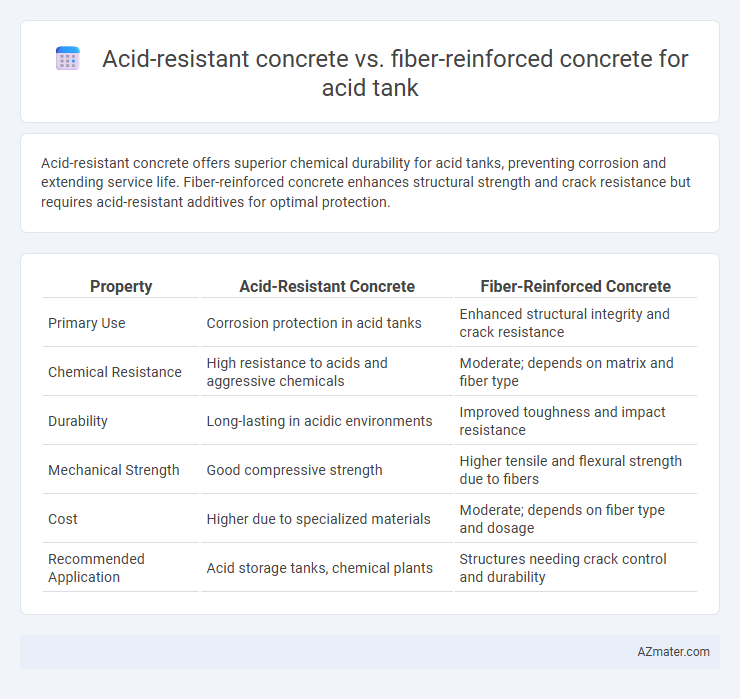Acid-resistant concrete offers superior chemical durability for acid tanks, preventing corrosion and extending service life. Fiber-reinforced concrete enhances structural strength and crack resistance but requires acid-resistant additives for optimal protection.
Table of Comparison
| Property | Acid-Resistant Concrete | Fiber-Reinforced Concrete |
|---|---|---|
| Primary Use | Corrosion protection in acid tanks | Enhanced structural integrity and crack resistance |
| Chemical Resistance | High resistance to acids and aggressive chemicals | Moderate; depends on matrix and fiber type |
| Durability | Long-lasting in acidic environments | Improved toughness and impact resistance |
| Mechanical Strength | Good compressive strength | Higher tensile and flexural strength due to fibers |
| Cost | Higher due to specialized materials | Moderate; depends on fiber type and dosage |
| Recommended Application | Acid storage tanks, chemical plants | Structures needing crack control and durability |
Introduction: The Need for Durable Acid Tank Materials
Acid tanks require materials that can withstand aggressive chemical corrosion and mechanical stress to ensure long-term structural integrity. Acid-resistant concrete offers enhanced chemical durability by incorporating special cement and aggregates that resist acid attack, while fiber-reinforced concrete improves tensile strength and crack resistance through the inclusion of synthetic or steel fibers. Choosing between these materials depends on balancing chemical resistance requirements with mechanical performance needs in acid storage environments.
Understanding Acid-Resistant Concrete
Acid-resistant concrete, specifically engineered with specialized aggregates and chemical-resistant binders, provides superior durability and protection against aggressive acidic environments commonly encountered in acid tanks. Unlike fiber-reinforced concrete, which primarily enhances mechanical strength and crack resistance, acid-resistant concrete focuses on chemical stability to prevent degradation and ensure long-term structural integrity. The selection of acid-resistant concrete involves optimizing its composition to resist specific acid concentrations, making it the preferred choice for applications requiring exceptional corrosion resistance.
Overview of Fiber-Reinforced Concrete
Fiber-reinforced concrete (FRC) enhances the structural integrity of acid tanks by incorporating synthetic, steel, or glass fibers that improve tensile strength, crack resistance, and durability against chemical exposure. Unlike traditional acid-resistant concrete which relies heavily on specialized cementitious materials and chemical additives to withstand corrosive environments, FRC offers improved toughness and longevity by controlling microcracking and mitigating spalling under acidic conditions. The optimized fiber distribution within FRC ensures better performance in acid storage applications, making it a cost-effective alternative for acid tank construction with enhanced mechanical properties and resistance to acid attack.
Chemical Resistance: Key Performance Factors
Acid-resistant concrete offers superior chemical resistance by incorporating specialized aggregates and chemical-resistant binders that withstand aggressive acid exposure in acid tanks. Fiber-reinforced concrete enhances durability by improving crack control and structural integrity but may exhibit lower resistance to prolonged acid corrosion compared to acid-resistant mixes. Selecting acid-resistant concrete with suitable polymer additives is crucial for maintaining tank longevity under highly acidic conditions.
Structural Integrity in Acidic Environments
Acid-resistant concrete incorporates specialized aggregates and chemical admixtures that enhance its durability and maintain structural integrity in highly corrosive acid tank environments. Fiber-reinforced concrete improves tensile strength and crack resistance, reducing the risk of structural failure due to acid-induced microfractures over time. Combining acid-resistant mix designs with fiber reinforcement optimizes long-term performance by mitigating chemical degradation and mechanical stresses in acidic conditions.
Durability and Lifespan Comparison
Acid-resistant concrete offers superior chemical resistance in acid tanks, significantly reducing surface erosion and extending lifespan under aggressive acidic environments. Fiber-reinforced concrete enhances mechanical strength and crack resistance, but may have limited durability when consistently exposed to highly acidic substances. Combining acid-resistant materials with fiber reinforcement can optimize durability and lifespan, providing both chemical protection and enhanced structural integrity.
Installation and Maintenance Considerations
Acid-resistant concrete offers superior chemical resistance, minimizing degradation during installation in acid tanks, while fiber-reinforced concrete enhances tensile strength and crack control, facilitating faster application and reducing curing time. Maintenance for acid-resistant concrete involves routine inspections for surface erosion and potential acid penetration, whereas fiber-reinforced concrete requires monitoring for fiber exposure and spalling to maintain structural integrity. Selecting the appropriate concrete depends on balancing initial installation speed with long-term durability and ease of maintenance in corrosive environments.
Cost Analysis: Acid-Resistant vs Fiber-Reinforced Concrete
Acid-resistant concrete typically incurs higher initial costs due to specialized materials like silica fume and corrosion inhibitors that enhance durability in acidic environments. Fiber-reinforced concrete offers a cost-effective alternative by improving tensile strength and crack resistance, potentially reducing maintenance expenses over time. When evaluating acid tank construction, balancing upfront investment with long-term performance and repair costs is crucial for optimal economic outcomes.
Case Studies: Real-World Acid Tank Applications
Case studies reveal acid-resistant concrete excels in acid tank applications by providing superior chemical durability against strong acids such as sulfuric and hydrochloric acid, minimizing corrosion and extending tank lifespan. Fiber-reinforced concrete enhances mechanical strength and crack resistance, critical for structural integrity under thermal and mechanical stress but may require additional chemical resistance treatments to prevent acid attack. Real-world acid tank installations demonstrate that combining acid-resistant concrete with fiber reinforcement offers optimal performance, balancing durability and structural resilience in harsh industrial environments.
Recommendations for Choosing the Optimal Concrete Solution
Selecting the optimal concrete for acid tanks requires prioritizing acid-resistant concrete due to its superior chemical stability and low permeability against corrosive substances. Fiber-reinforced concrete enhances mechanical strength and crack resistance but lacks the specialized chemical resistance needed for prolonged acid exposure. For environments with aggressive acids, acid-resistant concrete reinforced with suitable fibers offers a balanced solution combining durability and structural integrity.

Infographic: Acid-resistant concrete vs Fiber-reinforced concrete for Acid tank
 azmater.com
azmater.com